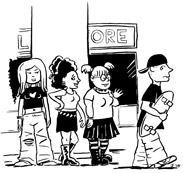Sex and teens

Pediatrician Franziska Baltzer
Claudio Calligaris
Franziska Baltzer, a pediatrician who has been director of the Adolescent Medicine and Gynecology Program at the Montreal Children's Hospital wants to talk about sex. On April 6, she will be presenting a public lecture, "Your Teen and Sex," at the Montreal Children's Hospital as part of the McGill University Health Centre's 2005 Public Lecture Series, Health Matters.
"Adolescents are being born into adulthood - it's as important as the intrauterine period in terms of growth," she says.
Baltzer and her staff in the Adolescent Medicine and Gynecology Program, an outpatient clinic of the Montreal Children's Hospital, receive about 5,300 visits each year - 90 percent of these are girls. "Boys are still the strong ones, who don't get sick, and certainly don't go for consultations," says Baltzer. "While women discuss problems looking for solutions, men often try to find them on their own."
The age at which sexual activity begins hasn't altered much over the last 10 years: at 16, 50 percent of teens are sexually active; at 18, 80 percent are active. The starting age is somewhere between 14 and 16 - but when kids younger than 14 are sexually active, it's a sign of trouble. "The group that starts early has always been the high-risk group - those who skip classes or drop out of school, or get involved with drugs or gangs. And they are often victims of sexual abuse."

Jack Ruttan
Children who are sexually abused learn to use sex as a basic means of communication. "They will not see sexual intercourse as the cherry on the top, with other types of communication before it - like talking, holding hands, going to movies. For them, it is normal to have sex early in the development of a relationship."
Baltzer, notes some major changes over the past decade in the way kids view sexual behavior. Some are positive, such as more condom use. "But 10 years ago, sex usually meant vaginal intercourse. Kids had very little knowledge of any other sexual practices," she says. "Today, however, teenage girls engage in oral sex and do not consider themselves sexually active. They're preserving their virginity - but they might get several phone calls over the weekend from boys who want blow jobs." The activity is largely one-way, she notes. "The kids really have to figure out what it means. Often the girls are giving - but what are they receiving in exchange?"
But sexualized communication, she notes, is becoming increasingly common. Consider the strange case of the sex bracelets. About two years ago, innocuous bracelets made of coloured strands of plastic were suddenly and inexplicably transformed: certain colours acquired coded meanings. Boys passing by girls wearing these bracelets would rip off one strand and demand the sexual activity associated with that colour. For instance, a white strand could represent oral sex; a blue, full-vaginal intercourse. The phenomenon spread from high school down to grade six; eventually, the bracelets were banned from schools. "I have no clue how it started, but it created major issues," says Baltzer. "It's very weird, but probably a result of sexualized thinking."
It isn't simply the kids, of course. "Our society has adopted more sexualized communication," she says, also noting the consequences of crumbling generational barriers. "Grandmothers are going to the gym to look sexy, and are wearing the same sorts of clothing as little girls. There are no set ages for when you behave and dress in certain ways, and while that can be good, there is also confusion." Marketers of jeans and clothing are targeting increasingly younger children for sexy attire. "Why should a seven-year-old have an off-the-shoulder top, or sexy underwear?" Baltzer asks. "Twenty years ago, a seven-year-old girl with sexy clothes, a handbag or makeup was probably a victim of sexual abuse. Today you can no longer make that inference - all kinds of kids dress this way." Consider the ubiquitous Playboy bunny, marketed on clothing, medallions and navel-rings to young teenagers who see only a cute bunny and have little understanding of its cultural symbolism. "They really don't know that they're identifying themselves as sex objects," she says. "The Playboy bunny raises some interesting questions: who brings these items onto the market, and what kinds of interpretations are they subject to? Kids are placing themselves at risk of being targeted by an older generation."
Catch Franziska Baltzer's presentation "Your Teen and Sex" on Wednesday, April 6, at 7:30 pm, in the Amphitheatre (Room D-182) of the Montreal Children's Hospital, 2300 Tupper St. (corner Atwater Avenue).
